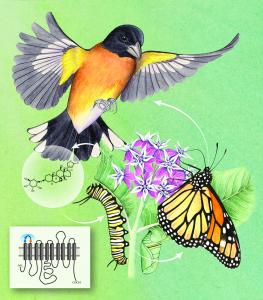
Monarch butterflies and their close relatives thrive on poisonous milkweed, thanks to genetic mutations that block the effects of the plant’s toxins while allowing the poisons to accumulate in the caterpillar or adult insects as deterrents to hungry predators.
Turns out some of those insect-eating predators evolved similar mutations in order to feast on monarchs.
“The toxins move up the food chain from plants — what biologists call the first trophic level — to insect herbivores, the second, and then to predators and parasitoids — a third trophic level,” said evolutionary biologist Noah Whiteman, UC Berkeley professor of integrative biology and of molecular and cell biology.